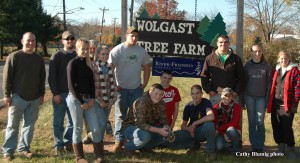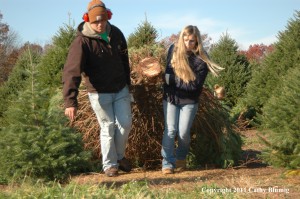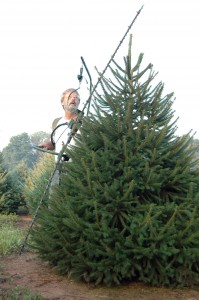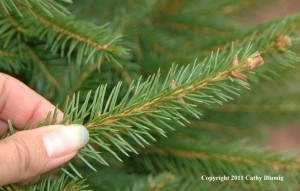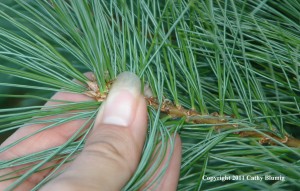Members of the Phillipsburg High School FFA chapter (Future Farmers of America) traveled from their haunts in Warren County to visit central New Jersey’s Wolgast Tree Farm in Somerset last Saturday. This was the third year that Phillipsburg FFA has visited our farm to get trees they will use to make grave blankets, and we consider it one of the highlights of the year when they do. They are enthusiastic, hard-working, and well-mannered kids, and they instill a lot of hope within us about the future and character of today’s young people. That they have an interest in agriculture and the outdoors is even better!
Before they headed out to the fields to cut trees, the students got a short tour, “A Year in the Life of a
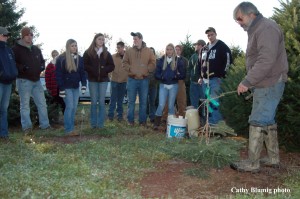
Len shows members of Phillipsburg High School FFA what bucks can do to Christmas trees with their antlers (make a "buck rub") and how we try to prevent the damage by spraying the trees with deer repellent. This didn't work as well as it might have this year because we had lots of rain that washed the repellent off.
Christmas Tree Farmer.” Len discussed how we plant seedlings, control weeds and insect pests, and shear Christmas trees, as well as prevent and correct damage to trees caused by male white-tailed deer. The chapter was invited to return in the spring to get a more detailed tour that would cover how we use Integrated Pest Management (IMP) on our farm, why our farm has been certified as being “River-Friendly,” and how we’ve integrated wildlife management into our operation to enhance the kinds of wildlife that visit, while aiming to minimize wildlife-caused damage.
It was a big job. The trees were cut, hauled out of the fields, and the branches were removed from the trunks. The branches were tied into small bundles, and loaded on to trucks and a trailer, and brought back to school. What made the task especially demanding was that the trees were very big.
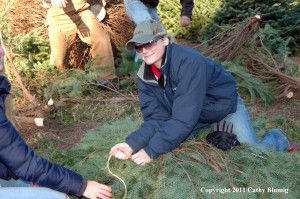
Bundling Douglas fir greens that Phillipsburg High School FFA members will use to make grave blankets that they will sell as part of their annual fund raiser.
Some of the trees were close to 200 pounds each! They had grown so large and heavy because some had double and triple trunks and weren’t suitable to be Christmas trees so they kept growing over the years. Rather than throw the trees away, they are used in other ways. The greens from these trees are beautiful, and we have been using them to make grave blankets and wreaths on our farm, and marketing them for the same purpose to others, like Phillipsburg FFA.
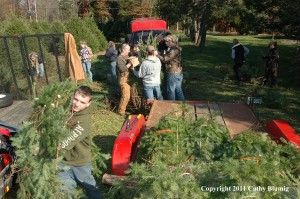
The crew of the Phillipsburg FFA bundling & loading Douglas fir greens from Wolgast Tree Farm in Somerset, NJ.
Despite being physically demanding, it was a fun day. The students have said their visit to our farm is among their most favorite activities of the year. From our end, we appreciate their interest in our trees, but even more we enjoy sharing our interest in agriculture and the outdoors with others, and the opportunity to see young, industrious people in action. It’s always a delight to have Phillipsburg High School FFA Chapter visit Wolgast Tree Farm!
